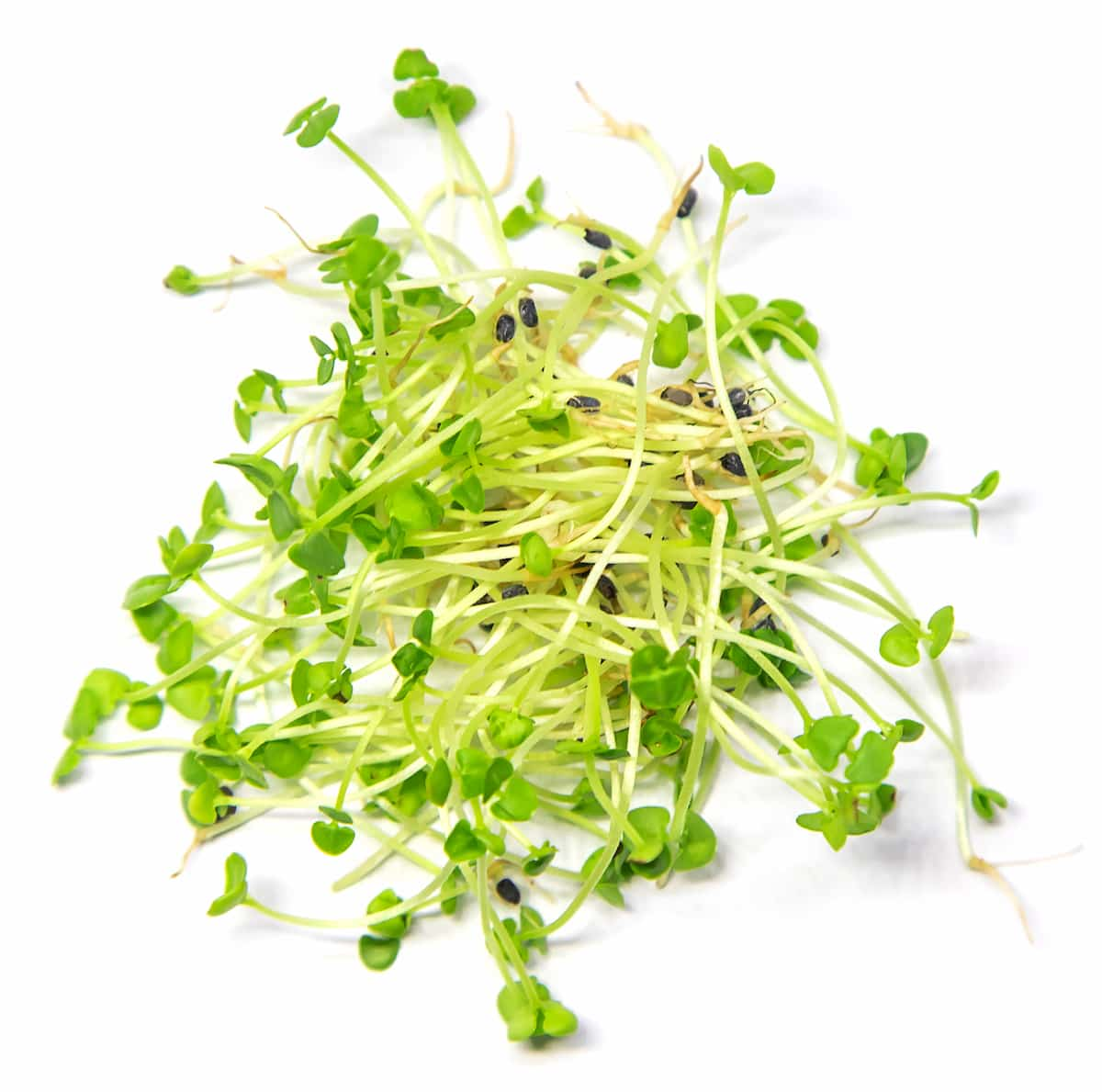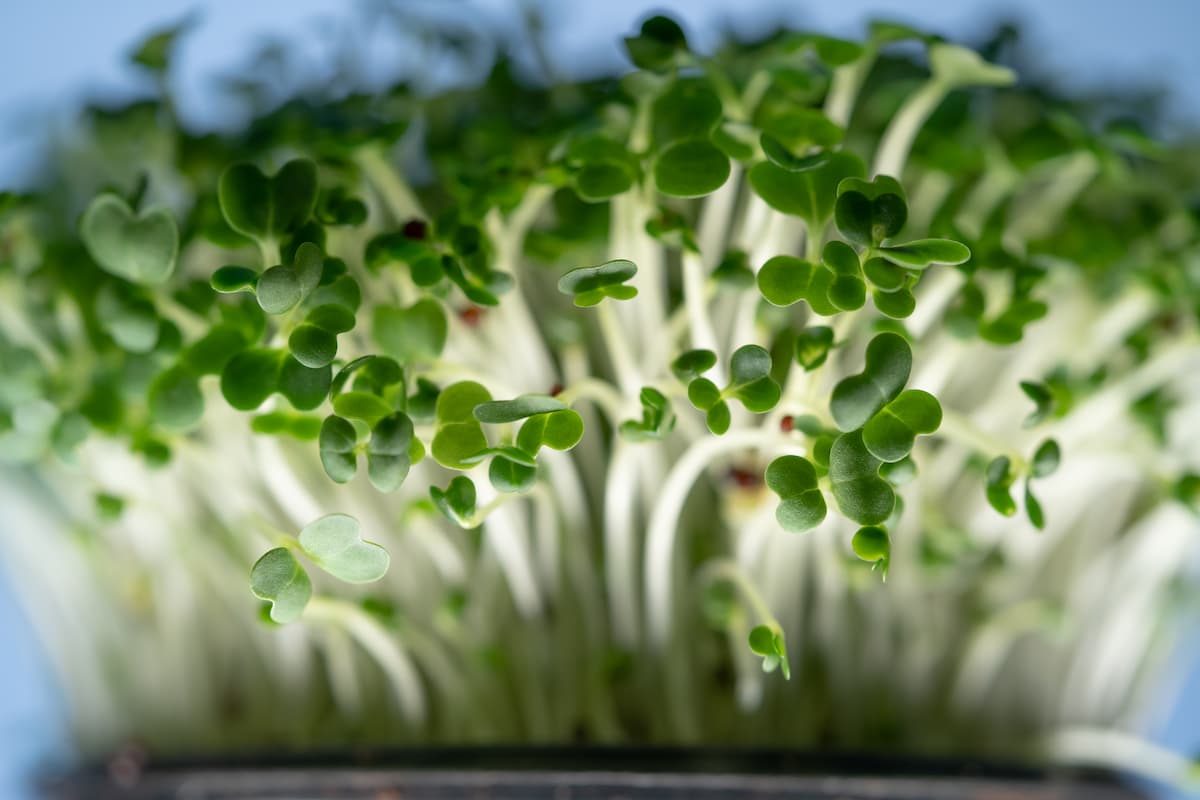Growing basil microgreens is a great way to enjoy fresh, nutritious greens at home while adding flavor and texture to your dishes. With minimal investment, basic supplies, and care, you can soon enjoy the delicious harvest of your first batch of homemade basil microgreens.

A Step-By-Step Guide for Growing Basil Microgreens
What are Basil Microgreens?
- Basil microgreens are a type of edible plant that is typically grown from basil seeds. They are harvested when the plants are young and can be used in various dishes.
- Basil microgreens have a milder flavor than mature basil plants, and they can be used in place of other greens in salads or as a Garnish.
Conditions to Grow Basil Microgreens Successfully
- To grow basil microgreens successfully, a few conditions must be met.
- The soil must be well-drained and moist but not too wet.
- The temperature should be warm, around 21°C.
- The plants should be in a sunny spot with at least 6 hours of sunlight daily.
- The containers should be shallow and have drainage holes to prevent the roots from getting waterlogged.
- If you’re interested in growing your Basil microgreens, it’s easy to do so with just a few supplies.
- You only need some potting soil, some Basil seeds, and a container to grow them in. You can find all these items at your local nursery or garden center.
- Once you have your supplies, fill your container with potting soil and sprinkle the Basil seeds.
- Water the soil until moist but not soaking wet, then place the container in a sunny spot. Keep the soil moistened, and you should see the first signs of growth within a week or two.
- Harvest your Basil microgreens when they are about 2-3 inches tall by snipping them off at the stem with scissors. Wash them well before using them, and enjoy them in any dish you like.
In case you missed it: A Step-by-Step Guide for Growing Kale Microgreens: DIY in Simple Way from Seeds in Containers

What is the Fastest Way to Germinate Basil Microgreens?
- Growing basil microgreens at home with just a few simple supplies is easy. You only need a container, potting mix, and basil seeds. You can start growing your basil microgreens in as little as a week.
- To get started, fill your container with potting mix and moisten it well. Then, sprinkle a thin layer of basil seeds over the surface of the potting mix. Gently press the seeds into the soil so that they make good contact with the moistened potting mix.
- Place your container in a warm location and keep the soil moist. Once they reach about 2-3 inches tall, you can begin harvesting your microgreens.
Grow Basil Microgreens Without Soil
You must purchase a few supplies if you plan to grow basil microgreens without soil in a hydroponic system. First, you will need a tray or container to hold your plants. You can find these at most home improvement stores or online. Next, you will need a hydroponic growing medium. Many media types are available, but we recommend using coco coir or perlite. These two media are lightweight and easy to work with.
You will need an air pump and airline tubing to aerate your water and provide oxygen to your plants. Once you have gathered your supplies, it is time to start growing. Fill your tray or container with your hydroponic medium of choice and moisten it with water. Then, sprinkle your basil seeds onto the surface of the medium. Make sure that the seeds are spaced evenly so that they have room to grow.
Cover the tray or container with a lid or plastic wrap and place it in a warm area out of direct sunlight. Check on your seeds daily and mist them with water if they begin to dry out. After about 5-7 days, you should see tiny basil seedlings poking through the surface of the medium. Once your seedlings have emerged, it is time to begin fertilizing them. You can use any liquid fertilizer designed for hydroponic systems.
How to Grow Basil Microgreens
Basil microgreens are a type of herb that can be grown indoors or outdoors. They have a slightly sweet yet savory flavor and can be used in various dishes. Microgreens are relatively easy to grow, and basil is no exception. You can grow your basil microgreens at home with just a few simple supplies and some basic knowledge. You’ll need the following:
- Basil seeds
- A growing tray or container
- Potting soil or coco coir
- Water
- A spray bottle
Once you have your supplies gathered, it’s time to start planting! Fill your growing tray or container with potting soil or coco coir, then lightly mist it with water. Next, sprinkle the basil seeds evenly over the surface of the soil. Again, mist the seeds lightly with water. You want the soil to be moist but not soggy. Place the tray in an area that receives indirect sunlight and allow the seeds to germinate. This will usually take 3-5 days.
Once the seeds have germinated, lightly mist them with water to moisten the soil. You should see the first set of true leaves emerge within 7-10 days. At this point, you can begin fertilizing your microgreens if desired. Once the microgreens reach 2-3 inches tall, they can be harvested carefully.
In case you missed it: A Step-by-Step Guide for Growing Kohlrabi Microgreens: DIY in Simple Way from Seeds in Containers

Tips for Growing Basil Microgreens
- Start with high-quality basil seeds. If you can find them, look for organic or non-GMO seeds.
- Fill your growing tray or container with potting mix or soil, and water it until it’s evenly moist.
- Sow the basil seeds thinly and evenly over the surface of the potting mix or soil. You don’t need to cover them with additional potting mix or soil. Just press them lightly into the surface.
- Place the tray in a bright, warm location. A south-facing windowsill is ideal. Keep an eye on the soil and water to keep it moist but not soggy.
Conclusion
It is easy to grow your basil microgreens right at home; you only need some soil, seeds, and a container. Microgreens are also a good source of nutrients, including vitamins A and C, and they can be a healthy addition to your diet.
- Feed Your Flock for Less: Top 10 Tips to Save on Chicken Feed
- Ultimate Guide to Ossabaw Island Hog: Breeding, Raising, Diet, and Care
- Hatching Answers: The Top 10 Reasons Your Chickens Aren’t Laying Eggs
- Eggs and Economics: Breaking Down the Cost of Raising Backyard Chickens
- Defend Your Greens: Proven Methods to Keep Iguanas Out of Your Garden
- Ultimate Guide to Cinnamon Queen Chicken: A Comprehensive Guide for Beginners
- Ultimate Guide to California Tan Chicken: Breeding, Raising, Diet, Egg-Production and Care
- Ultimate Guide to Marsh Daisy Chicken: Breeding, Raising, Diet, and Care
- 10 Types of Chicken Farming Businesses You Can Start for Profits